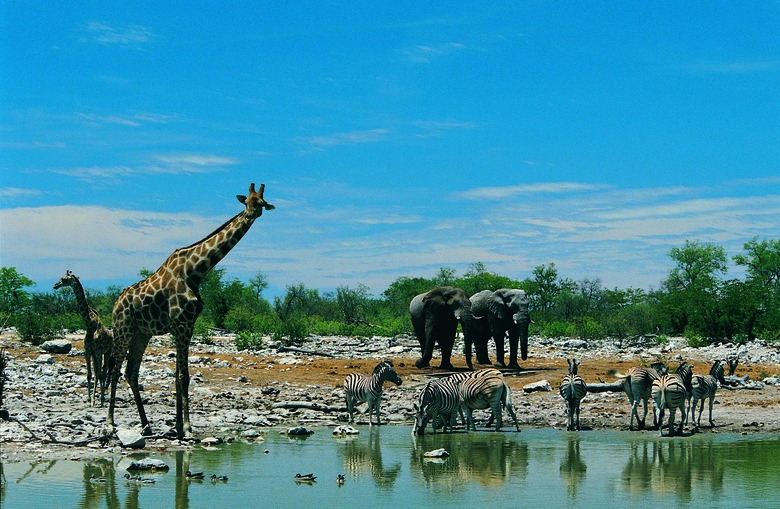Definition Of Net Ecosystem Exchange
An ecosystem includes animals, plants, microbes and the nonliving habitat components around them, such as water, air, and soil. Each living organism requires a certain form of energy production. All animals require respiration, the exchange of oxygen for carbon dioxide, to stay alive. Plants also require respiration and oxygen, but they also fix or remove carbon from the environment and produce life-giving oxygen used by animals, fueled by solar energy they harvest using specialized organelles called chloroplasts. The net ecosystem exchange is calculated by a formula that shows how much carbon is put into the environment compared to how much is removed. Net ecosystem exchange is also sometimes called "net ecosystem production."
The Carbon Cycle
The Carbon Cycle
To maintain life on earth as it is now, carbon in the atmosphere and carbon fixed in biological organisms need to be balanced. If not, climate change will result. Animals and people add more carbon to the ecosystem by simply breathing. Atmospheric carbon is also produced by decay, as dead animals and plant matter release carbon stored in their tissues, and by the combustion of trees, plants and fossil fuels, such as:
- oil
- coal
To counteract these effects, living plants are referred to as "carbon sinks" because they remove carbon dioxide from the environment and transform it into oxygen and food energy.
Key Factors and Terms
Key Factors and Terms
Several factors are needed to determine the net ecosystem exchange. The first is net primary production, which is the net amount of organic carbon removed from the ecosystem by plants. Plants are autotrophs, which means that they are able to form nutrients and energy from inorganic substances and sunlight during a process called photosynthesis. The total amount of carbon fixed — removed from the ecosystem — during photosynthesis is called gross primary production. However, plants also give off carbon during respiration. Hence, net primary production is calculated by subtracting the amount of carbon given off by plants during respiration from the amount of carbon fixed during gross primary production.
Determining Net Ecosystem Exchange
Determining Net Ecosystem Exchange
While plants are autotrophs, humans and animals are heterotrophs, meaning that they require organic nutrients — food — from the environment and must use oxygen to produce energy from digested food. Heterotrophic respiration produces large amounts of carbon that is put into the ecosystem. Hence, net ecosystem exchange is determined by subtracting the amount of carbon produced by heterotrophic respiration from the net primary production.
Properties of Ecosystems
Properties of Ecosystems
Carbon balance is a fundamental property that ensures that ecosystems are sustainable and healthy. Net ecosystem exchange helps to gauge the balance of the carbon cycle. As it is calculated by subtracting how much carbon plants fix or remove, from how much carbon is put into the ecosystem, the best result would be a negative value. For example, data from 1992 to 2000 showed that forests in the eastern United States had net ecosystem exchanges ranging from -84 to -740. This indicates that more carbon is being removed than is released. If carbon is not removed efficiently, the quality of air — and life — in an ecosystem will suffer. Other factors to consider for carbon balance in an ecosystem is pollution from factories and vehicles, while oceans also remove carbon from the atmosphere.
References
- Ecosystems: Is Net Ecosystem Production Equal to Ecosystem Carbon Accumulation? 2006
- Steverox.info: Definitions Of Some Ecological Terms Commonly Used In Carbon Accountin
- National Geographic: Our Carbon Footprint
- Environmental Science Division, Oak Ridge National Library: North American Net Ecosystem Exchange: Regionalization of AmeriFlux Observations
Cite This Article
MLA
, June Kane. "Definition Of Net Ecosystem Exchange" sciencing.com, https://www.sciencing.com/definition-net-ecosystem-exchange-6802053/. 24 April 2017.
APA
, June Kane. (2017, April 24). Definition Of Net Ecosystem Exchange. sciencing.com. Retrieved from https://www.sciencing.com/definition-net-ecosystem-exchange-6802053/
Chicago
, June Kane. Definition Of Net Ecosystem Exchange last modified August 30, 2022. https://www.sciencing.com/definition-net-ecosystem-exchange-6802053/
